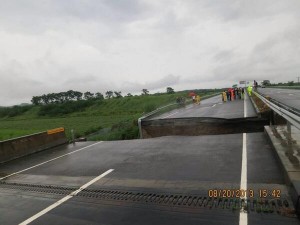‘Nando’ closes bridges in northern Luzon
CAUAYAN CITY, Philippines — Heavy rain dumped by Tropical Storm “Nando” on Monday night and Tuesday raised water levels in rivers in Isabela and Cagayan, rendering the Alicaocao overflow bridge here impassable, reports from the Provincial Disaster Risk Reduction and Management Council said.
The bridge closure cut off access to at least 10 barangays (villages) in this city, the PDRRMC said.
Also on Tuesday, the Department of Public Works and Highways closed the Cabagan-Santa Maria and Sto. Tomas-Cabagan overflow bridges after the water level in the Pinacanauan River rose.
In Ramon town, Magat Dam operators opened a flood gate two meters as the water level rose to 191.38 meters above sea level (masl), just 1.62 meters from its spill level of 193 masl.
The water level in the Cagayan River also rose due to the continuous release of water from the Magat, the reports said. Intermittent rains fell in northern Isabela.
The PDRRMC as of Tuesday had yet to receive reports of typhoon-related casualties and damage to agriculture and infrastructure.
The Philippine Atmospheric, Geophysical and Astronomical Services Administration (Pagasa) said Nando was estimated at 210 kilometers east of Aparri, Cagayan, on Tuesday morning. The storm is forecast to move north-northwest at 15 kilometers per hour and is expected to be 100 km north of Basco, Batanes, today and 460 km north of Basco on Thursday.
Public storm signal No. 2, indicating 61-100 kph winds, was raised over the Batanes group of islands, while signal No. 1, indicating 45-60 kph winds, was declared over Cagayan, the Calayan and Babuyan groups of islands, Apayao and Isabela.
As of 4 p.m. Tuesday, the storm (international name “Kong-Rey”) was spotted 270 km east of Casiguran, Aurora, Pagasa said.
Nando was packing peak winds of 65 kph near the center and gustiness of up to 80 kph, forecasters said.
Pagasa estimated the storm would spawn heavy to intense rainfall (10-25 millimeters per hour) within its 400-km diameter.
Nando is seen to continue bringing moderate to heavy rain to the provinces of Ilocos Norte and Ilocos Sur. It will also continue to enhance the southwest monsoon, spawning light to moderate and at times heavy rains and thunderstorms over Metro Manila and the rest of Luzon, Pagasa said.
“Sea travel is risky over the eastern seaboard of southern and Central Luzon,” it warned.
Based on Pagasa’s 24-hour weather outlook, the Batanes group of islands will experience stormy weather with rough to very rough seas.
The provinces of Isabela, Apayao and Cagayan, including the Babuyan and Calayan groups of islands, will have rains with gusty winds with moderate to rough seas.
Metro Manila and the rest of Luzon will have cloudy skies with light to moderate rain showers and thunderstorms, while the Visayas and Mindanao will be partly cloudy to cloudy with isolated rain showers or thunderstorms, Pagasa said.
Meanwhile, the combined losses to agriculture in the aftermath of Typhoons “Labuyo” and “Maring” climbed to P3.22 billion, according to the Department of Agriculture (DA).
Latest DA data showed that a total of 237,522 metric tons (MT) of produce was lost.
Maring alone ravaged 14,868 MT of crops valued at P766 million.
Of the total damage, corn accounted for around two-thirds of it or P2.13 billion. This represented 203,319 MT of grain covering 99,125 hectares.
The palay lost to the heavy rains was valued at P939.73 million or 29 percent of the total damage. This accounted for 23,616 MT on 56,030 ha that were inundated.
Agriculture Secretary Proceso J. Alcala, in an interview, said the two typhoons accounted for around a tenth of the palay lost due to bad weather so far this year.
“We’ve lost a total of 200,000 metric tons of palay since January,” Alcala said.
“But under the food staples sufficiency program, we have provided measures for expected damage of up to 600,000 metric tons for the entire year,” he said. With a report from Ronnel W. Domingo















